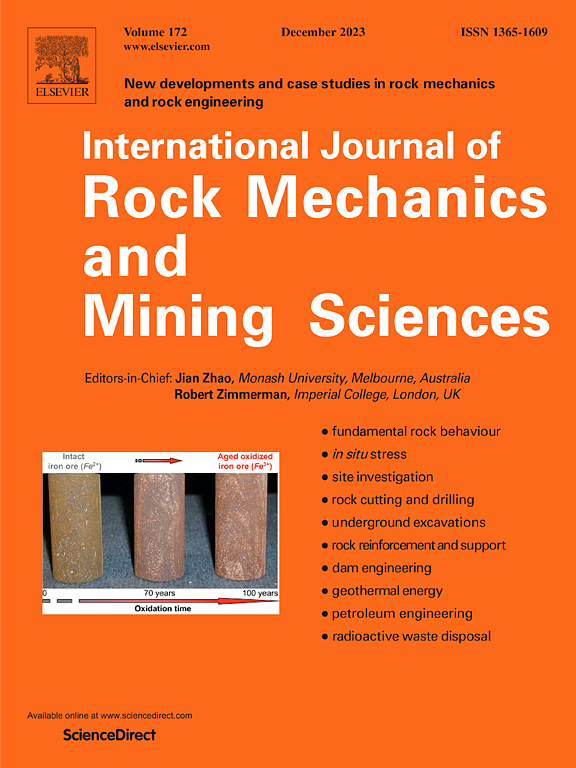煤层气抽采钻孔裂缝划分与两相流密封的实验验证与机理解析
IF 7
1区 工程技术
Q1 ENGINEERING, GEOLOGICAL
International Journal of Rock Mechanics and Mining Sciences
Pub Date : 2025-02-01
DOI:10.1016/j.ijrmms.2024.106021
引用次数: 0
摘要
煤层气已成为一种重要的清洁能源。煤层气的有效开采在很大程度上依赖于瓦斯抽放钻孔裂缝的密封材料。本研究将裂缝范围划分为不同的单宽度裂缝。针对传统“固封气”方法的局限性,提出了一种基于“液封气”原理的两相颗粒黏液密封材料(PMSM)方法。该方法涉及使用改性膨润土作为基础黏液材料,柔性和刚性颗粒的组合作为密封材料。建立了分级颗粒多级宽度裂纹的数学模型,并开发了相应的计算软件。通过单缝密封、范围缝密封试验,研究注浆压力、表面粗糙度、裂缝位置、钻孔角度等因素对密封性能的影响。结果表明,最佳颗粒黏液的泄漏量(LA)为12.29 g,密封时间(ST)为3.7 s。在0.4 MPa时,LA约为7 g, ST约为6.7 s。在表面粗糙度方面,粗糙裂纹模型的浆液扩散距离比光滑裂纹模型小10 mm。对于裂纹位置,180°时ST和泄漏体积最小。在井眼角度试验中,向上井眼ST和LV随井眼角度增大,向下井眼ST和LV随井眼角度减小。新材料的密封性能优于传统水泥材料。新型颗粒密封材料的最大平均负压为98 kPa,恢复到原气压所需时间是水泥材料的5倍。最后总结了颗粒封堵裂缝的机理,包括封堵、支撑和充填三种作用。该研究提出了颗粒和复杂裂纹密封理论,为加强煤层气抽提研究提供了新的思路。本文章由计算机程序翻译,如有差异,请以英文原文为准。
Experimental validation and mechanistic elucidation of crack division and two-phase flow-mediated sealing in coalbed methane extraction boreholes
Coalbed methane (CBM) has emerged as a key clean fuel. The efficient recovery of CBM heavily relies on the materials used to seal cracks in gas drainage boreholes. This study divides the range of cracks into different single width cracks. A method of using two-phase particle mucus sealing material (PMSM) based on the “Liquid-Sealing-Gas (LSG)" principle is proposed to address the limitations of traditional “Solid-Sealing-Gas (SSG)" methods. The method involves the use of modified bentonite as the basis mucus material and a combination of flexible and rigid particles as the sealing materials. A mathematical model of graded particles' multi-level width cracks is established, and corresponding calculation software is developed. Through experiments on single crack sealing, range crack sealing, and investigations of the effects of various factors such as grouting pressure, surface roughness, crack location, and borehole angle and the sealing performance are analyzed. The results show that the best particle mucus show performance with an leakage amount (LA) of 12.29 g and an sealing time (ST) of 3.7 s. At 0.4 MPa, LA is around 7 g and ST is 6.7 s. Regarding surface roughness, the rough crack model has a 10 mm smaller slurry diffusion distance than the smooth one. For crack location, ST and leakage volume (LV) are smallest at 180°. In borehole angle tests, in upward boreholes, ST and LV increase with angle, while in downward ones, they decrease. The sealing performance of the new material is superior to that of traditional cement materials. The new particle sealing material has a maximum average negative pressure of 98 kPa and the time required to restore to the original air pressure is five times that of cement materials. Finally, the mechanism of particle sealing cracks is summarized, including three function: blocking, supporting, and filling. This study advances the theory of particle and complex crack sealing, offering novel insights for enhancing CBM extraction research.
求助全文
通过发布文献求助,成功后即可免费获取论文全文。
去求助
来源期刊
CiteScore
14.00
自引率
5.60%
发文量
196
审稿时长
18 weeks
期刊介绍:
The International Journal of Rock Mechanics and Mining Sciences focuses on original research, new developments, site measurements, and case studies within the fields of rock mechanics and rock engineering. Serving as an international platform, it showcases high-quality papers addressing rock mechanics and the application of its principles and techniques in mining and civil engineering projects situated on or within rock masses. These projects encompass a wide range, including slopes, open-pit mines, quarries, shafts, tunnels, caverns, underground mines, metro systems, dams, hydro-electric stations, geothermal energy, petroleum engineering, and radioactive waste disposal. The journal welcomes submissions on various topics, with particular interest in theoretical advancements, analytical and numerical methods, rock testing, site investigation, and case studies.

 求助内容:
求助内容: 应助结果提醒方式:
应助结果提醒方式:


